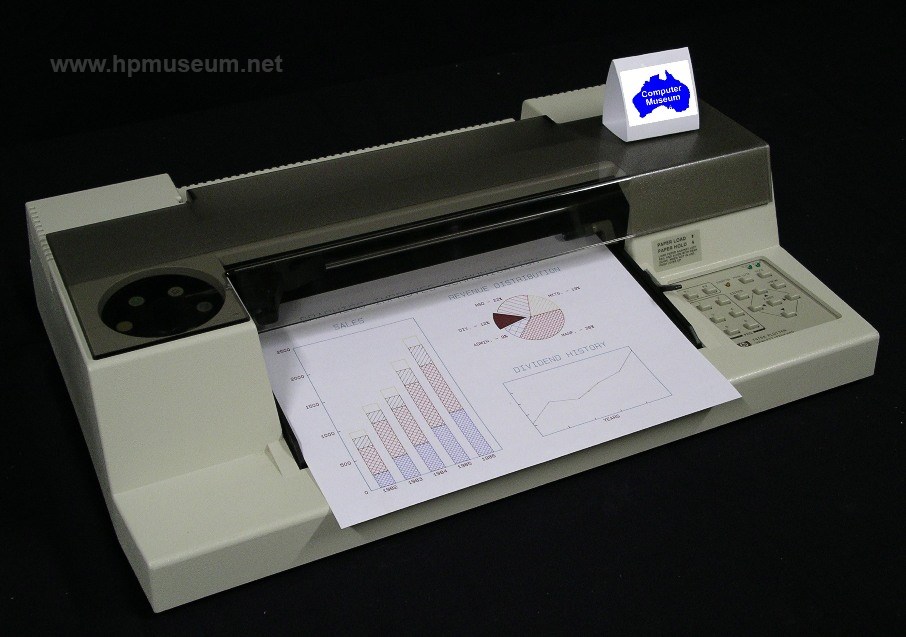 |
| HP7475 plotter Image credit: HP Computer Museum |
The statute of limitations is long past for me to use this in our regular ewaste feature. It's a bad fit in any case. The 7475 weighed a bit more than 15 pounds. I think junk that large is really more than ewaste. The plotter really should have been decommissioned and struck from the register of ships.
It was a great machine, though bulky and slow. HP had ditched the entire line a few years earlier. I got the unit used and never used it much.
I've had two different 2D cutting machines in my house in the last month. Each of these machines is a pale, though much lighter, imitation of the 7475. These cutters, a Cricut mini and a Silhouette Cameo, cut thin stock with a knife. The 7475 drew with one pen at a time but could automatically switch pens from a six pen carousel. A blade holder is still available for that machine that would allow it to do the job of these newer cutters.
The first of the new machines was the Cricut mini. I don't think I can find the polite, neutral language to summarize the Cricut business concept in a way that minimizes our total liability. I can imagine another company, though, with the slogan "We don't think our customers are stupid, we know it!". If that company also thought that its customers were filthy pirates, that company would probably build hardware and software that looked and acted like the Cricut mini.
Earlier machines from Cricut were configured to allow users to breezily install expensive cartridges that contained licenses for some shapes and then cut those shapes into a variety of materials without the need for a PC. The 'mini' machine eliminates all those buttons and frills. It requires a PC, Cricut software, and an Internet connection to use the machine.
I never intended to use the provided software. I thought I would just use it with Inkscape or a standalone tool to cut SVG dinosaurs for my kids. ProvoCraft, the concern behind Cricut, uses a very simple protocol for these devices and helpfully encrypts the link so that users can know exactly where stand with the company. ProvoCraft has always encrypted the link but earlier machines did a poor job that was widely cracked. A number of tools exist for those models that allow them to be used in just the way I imagined.
I'm not a filthy pirate. I'm not misusing a machine sold for below its cost. The cutter head transport reminds me of the Commodore VIC-1525 printer. The head has depth adjustment that must have been lifted directly from that printer. That printer was cheap and nasty even by 1980's home micro standards. I'm sure that ProvoCraft is not selling this device at a loss. I have no interest in cloning or even using their cartridges. I just want to cut and draw like it's 1989.
After I discovered that the existing open tools wouldn't work on the machine, I decided to try ProvoCraft's tool. I thought that it might do until intrepid hobbyists sorted the openness issues.
The Cricut Studio program isn't really a program. It's an Adobe Air wrapper for the Cricut website that lets that web app reach out and touch your printer over USB. No Internet? No program!
I ran the app and tried to create an account on the Cricut servers so that I could get started. I got a message that told me that the Cricut Studio beta program was full. This was for the only software that works for this device. Awesome. I called customer service. They told me that today was the very first day for their new website design and that I should probably try again later. I actually did manage to contain my rage long enough to try later. Just as I thought I was about to succeed and cut a square on some paper, the app decided that my firmware (version XXX) was too old and needed to be updated to a newer version. I allowed it to proceed. The printer came back online reporting firmware version 0.01.
Unsurprisingly, the software decided that this was too old and that an update was needed. This loop
continued until I unplugged the machine, put it back in its box, and whisked it back to the store.
Provocraft placed me and their other users at the mercy of terrible application software. Lots of firms do that. Provocraft placed me at the mercy of incompetent web administrators. Lots of firms do that too. Provocraft went farther. Provocraft pulled off an amazing triple Lutz the likes of which Utah hasn't seen since the 2002 Winter Olympics in Salt Lake City. They broke their app, their website, and their own hardware in a single, fluid motion. I'm at peace now. I no longer hope that someone broke their ankle on the landing.
I missed the HP 7475. It had a serial port. You could talk to it with a terminal program. You could drive it from Lotus 1-2-3 or gnuplot. E.T. could probably have connected it to a Speak & Spell with little difficulty.
I ordered the Silhouette Cameo from Amazon while I was at a traffic light on my way to return the Cricut. It arrived in about a day. In about a day, you'll be able to read the next installment of this piece. Only reograph brings you tape-delayed live blogging.
No comments:
Post a Comment